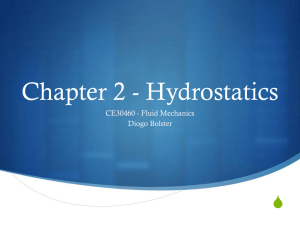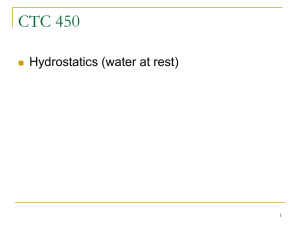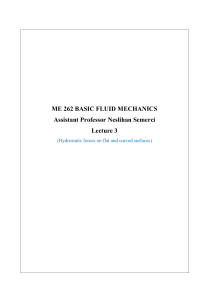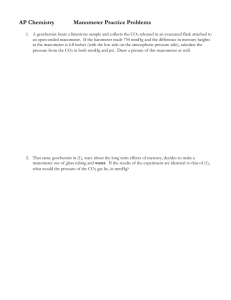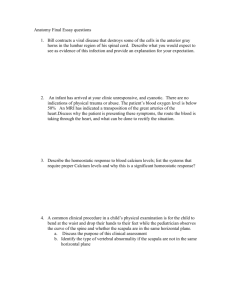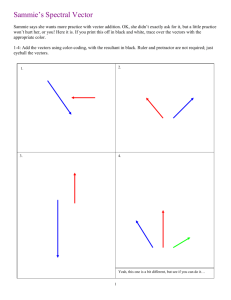ch2-hydrostatic
advertisement
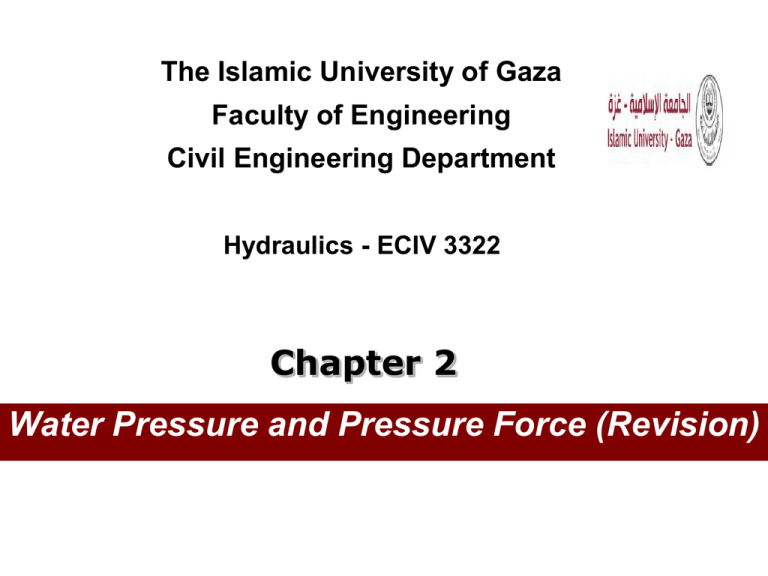
The Islamic University of Gaza Faculty of Engineering Civil Engineering Department Hydraulics - ECIV 3322 Chapter 2 Water Pressure and Pressure Force (Revision) 2.1 Free Surface of Water • A horizontal surface upon which the pressure is constant every where. • Free surface of water in a vessel may be subjected to: - atmospheric pressure (open vessel) or, - any other pressure that is exerted in the vessel (closed vessel). 2 2.2 Absolute and Gage Pressures • Atmospheric pressure is approximately equal to a 10.33-m-high column of water at sea level. • Any object located below the water surface is subjected to a pressure greater than the atmospheric pressure (P > Patm). Let: dA = cross-sectional area of the prism. the prism is at rest. So, all forces acting upon it must be in equilibrium in all directions. 3 Equilibrium in x- direction: Fx = PA dA – PB dA + g L dA sin q = 0 PB – PA = g h The difference in pressure between any two points in still water is always equal to: the product of the specific weight of water (g) and the difference in elevation between the two points (h). Notice that: • If the two points are on the same elevation, h = 0 PA=PB • In other words, for water at rest, the pressure at all points in a horizontal plane is the same. 4 If the water body has a free surface that is exposed to atmospheric pressure, Patm. Point A is positioned on the free surface such that PA= Patm (PB )abs= PA + g h = Patm + g h = absolute pressure Pressure gages: are usually designed to measure pressures above or below the atmospheric pressure. Gage pressure: is the pressure measured with respect to atmospheric pressure (using atmospheric pressure as a base). Absolute pressure: Pabs = Pgage + Patm Pressure head, h = P/g 5 The difference in pressure heads at two points in water at rest is always equal to the difference in elevation between the two points. (PB /g) – (PA /g) = D(h) Notice that: • Any change in pressure at point B would cause an equal change at point A, because the difference in pressure head between the two points must remain constant = h. Pascal's law : A pressure applied at any point in a liquid at rest is transmitted equally and undiminished in all directions to every other point in the liquid. This principle has been made use of in the hydraulic jacks that lift heavy weights by applying relatively small forces. 6 Example 2.1 7 2.3 Surface of Equal Pressure • The hydrostatic pressure in a body of water varies with the vertical distance measured from the free surface of the water body. • All points on a horizontal surface in the water have the same pressure. 8 2.4 Manometers A manometer Is a tube bent in the form of a U containing a fluid of known specific gravity. The difference in elevations of the liquid surfaces under pressure indicates the difference in pressure at the two ends. Two types of manometers: 1. An open manometer: has one end open to atmospheric pressure and is capable of measuring the gage pressure in a vessel. 2. A differential manometer: connects each end to a different pressure vessel and is capable of measuring the pressure difference between the two vessels. 9 10 • The liquid used in a manometer is usually heavier than the fluids to be measured. It must not mix with the adjacent liquids (i.e., immiscible liquids). • The most used liquids are: - Mercury (specific gravity = 13.6), - Water (sp. gr. = 1.00), - Alcohol (sp. gr. = 0.9), and - Other commercial manometer oils of various specific gravities. 11 A simple step-by-step procedure for pressure computation Step1: Make a sketch of the manometer system approximately to scale. Step 2: Draw a horizontal line at the level of the lower surface of the manometer liquid, M. The pressure at points 1 and 2 must be the same since the system is in static equilibrium. Step 3: a) For open manometers P2 = P1 gM.h = gW.y + PA PA = gM.h - gW.y 12 A simple step-by-step procedure for pressure computation b) For a differential manometers P2 = P1 gM.h + gw .(y - h) + PB = gW.y + PA DP = PA – PB = h (gM - gw ) 13 Example 2.2 Determine the pressure difference DP Solution: 14 Single-reading manometer A differential manometer installed in a flow - measured system 15 2.5 Hydrostatic Force on a Flat Surface • The area AB of the back face of a dam inclines at an angle (q ), and, • X - axis lies on the line at which the water free surface intersects with the dam surface, • Y - axis running down the direction of the dam surface. h h horizontal view projection of AB on the dam surface 16 • For a strip at depth h below the free surface: P γ h γ y sin θ dF γ y sin θ.dA • The total pressure force over the surface: F dF γ y sin θ.dA γ sin θ.A. y A F γ .h.A A Where: y y dA A is the distance measured from the x-axis to the A centroid (C.G.) of the plane The total hydrostatic pressure force on any submerged plane dF γ y sin θ.dA surface is equal to the product of the surface area and the pressure acting at the centroid (C.G.) of the plane surface. 17 Notes: • Pressure forces acting on a plane surface are distributed over every part of the surface. • They are parallel and act in a direction normal to the surface. • They can be replaced by a single resultant force F = g h`A. acting normal to the surface. • The point on the plane surface at which this resultant force acts is known as the center of pressure (C.P.). • The center of pressure of any submerged plane surface is always below the centroid of the surface (Yp > Y`). YP y dF A F 2 y dA A Ay Ix I o Ay 2 I o y Mx Ay Ay 18 The centroid, area, and moment of inertia with respect to the centroid of some common geometrical plane surfaces are given below. 19 Example 2.3 For the vertical trapezoidal gate, Determine F and YP Solution: 20 Example 2.3 Determine F and YP Solution: 21 2.6 Hydrostatic Forces on Curved Surfaces • The hydrostatic force on a curved surface can be best analyzed by resolving the total pressure force on the surface into its horizontal and vertical components. • Then combine these forces to obtain the resultant force and its direction. 22 F x 0 FH FA' B • FH = Resultant force on the projection of the curved surface onto a vertical plane. • FH acts horizontally through the centre of pressure of the projection of the curved surface onto a vertical plane. • We can use the pressure diagram method to calculate the position and magnitude of the resultant horizontal force on a curved surface. F y 0 FV WAA' WABA' • FV = The resultant vertical force of a fluid above a curved surface equal to the weight of fluid directly above the curved surface. • It acts vertically downward through the centre of gravity of 23 the mass of fluid. Resultant force • The overall resultant force is found by combining the vertical and horizontal components vectorialy: F FH2 FV2 • The angle the resultant force makes to the horizontal is: FV q tan FH 1 • The position of F is the point of intersection of the horizontal line of action of FH and the vertical line of action of FV . 24 Pressure distribution on a semi-cylindrical gate 25 26 27

